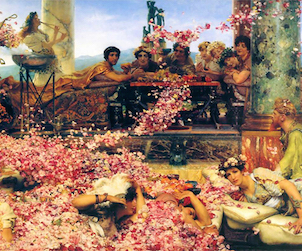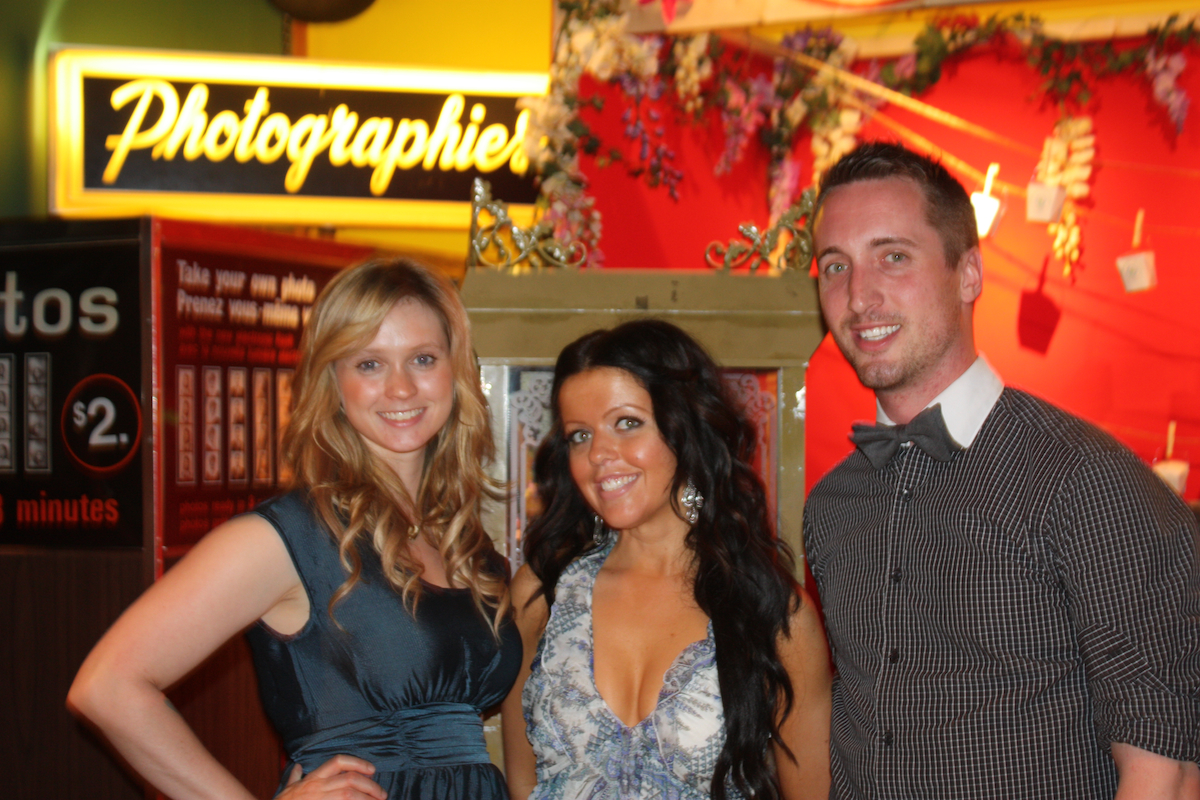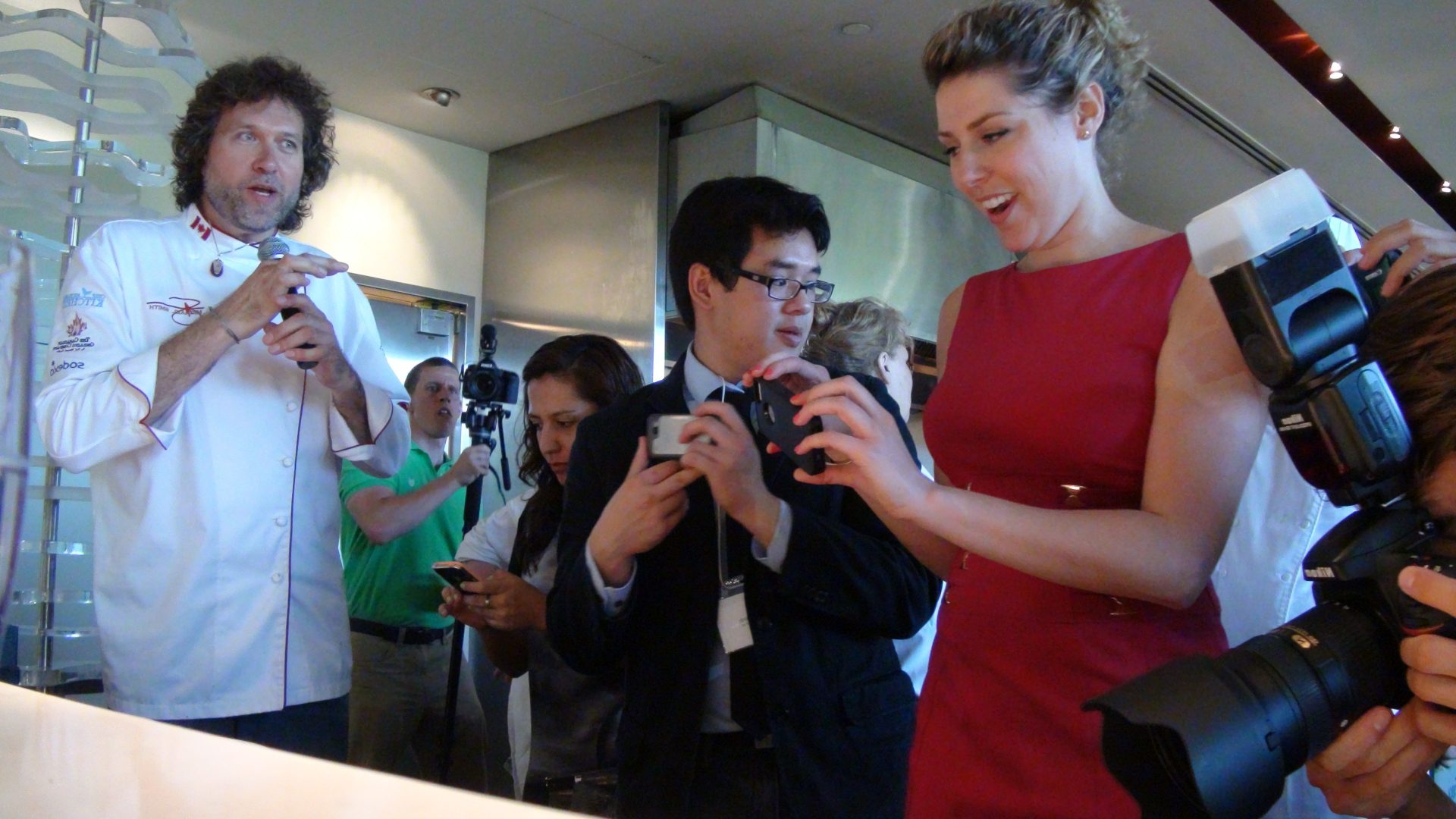Wine and Art is an ongoing GFR series on the relationship between the two creative endeavours by working artist and author Lorette C. Luzajic.  It’s probably not true, but the legend is nice. It goes like this: once upon a time, there was a French Benedictine monk who found some wine that had gone fizzy. His name was Dom Perignon. When he tried the concoction, the story goes, he called out, “Come quickly, I am tasting stars!” When I first heard this tale, an image flashed into my mind’s eye, of the old monk roaming through the purple swirling fields of June under Van Gogh’s Starry Night. He made a striking figure in that setting with his mysterious flowing robe. Today, I cannot look at Starry Night without this fleeting and fictional memory: the invention of champagne.
It’s probably not true, but the legend is nice. It goes like this: once upon a time, there was a French Benedictine monk who found some wine that had gone fizzy. His name was Dom Perignon. When he tried the concoction, the story goes, he called out, “Come quickly, I am tasting stars!” When I first heard this tale, an image flashed into my mind’s eye, of the old monk roaming through the purple swirling fields of June under Van Gogh’s Starry Night. He made a striking figure in that setting with his mysterious flowing robe. Today, I cannot look at Starry Night without this fleeting and fictional memory: the invention of champagne.  At New Year’s, my bestie announced she hadn’t been drinking enough champagne. This needed correcting, she said, and would be her resolution. I like bubbly as much as the next person, I suppose, delighting when it makes an unexpected appearance at the table. But as a lover of blood red wine with the weight of granite, I’m usually guilty of thinking I’ve got to hurry through it on my way to the real thing. But oh, starry night! In this endless frozen darkness, with winter dragging its heels well into March, champagne is a flight of fancy. One cannot melt the snow, but one can wish in the softness of Spring with some fizzy, fuzzy sparkling sweetness. Tonight, we can open the window and walk through Van Gogh’s fresh fields to summon her. I pour from a neglected gift – Champagne Victorie Brut Prestige. It’s actually dusty while all the bottles of red are empty! Sad. I know nothing about champagne, so I check out the LCBO description and try to find the “brioche” and “apple” notes and weigh in on the “lively acidity.” And I think I’m in love.
At New Year’s, my bestie announced she hadn’t been drinking enough champagne. This needed correcting, she said, and would be her resolution. I like bubbly as much as the next person, I suppose, delighting when it makes an unexpected appearance at the table. But as a lover of blood red wine with the weight of granite, I’m usually guilty of thinking I’ve got to hurry through it on my way to the real thing. But oh, starry night! In this endless frozen darkness, with winter dragging its heels well into March, champagne is a flight of fancy. One cannot melt the snow, but one can wish in the softness of Spring with some fizzy, fuzzy sparkling sweetness. Tonight, we can open the window and walk through Van Gogh’s fresh fields to summon her. I pour from a neglected gift – Champagne Victorie Brut Prestige. It’s actually dusty while all the bottles of red are empty! Sad. I know nothing about champagne, so I check out the LCBO description and try to find the “brioche” and “apple” notes and weigh in on the “lively acidity.” And I think I’m in love. 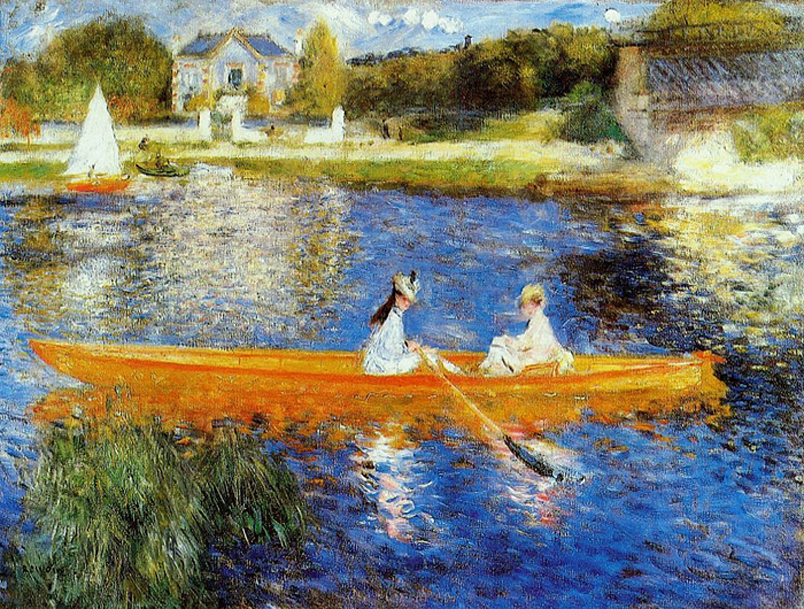 As with the sparkly stuff, I have too often found the art of Impressionists like Monet and Renoir painfully saccharine. When I’m in one of my less charitable moods, I feel they are but paintings with a pretty face, with little substance behind their unbearable lightness of being. My problem is that I’ve always had a penchant for trouble over sweetness, and generally prefer the study of depictions of Judith Slaying Holofernes to insipid garden paintings. But man cannot live by Gentileschi and Goya alone. There are times when the ebullience of Pissarro’s blossoms and the buoyant laughter of ladies in Renoir’s sidewalk cafes can comfort a soul desperate for sunshine. On another dark and endless frozen March night, some pink stars and Paris flowers are just what the doctor ordered.
As with the sparkly stuff, I have too often found the art of Impressionists like Monet and Renoir painfully saccharine. When I’m in one of my less charitable moods, I feel they are but paintings with a pretty face, with little substance behind their unbearable lightness of being. My problem is that I’ve always had a penchant for trouble over sweetness, and generally prefer the study of depictions of Judith Slaying Holofernes to insipid garden paintings. But man cannot live by Gentileschi and Goya alone. There are times when the ebullience of Pissarro’s blossoms and the buoyant laughter of ladies in Renoir’s sidewalk cafes can comfort a soul desperate for sunshine. On another dark and endless frozen March night, some pink stars and Paris flowers are just what the doctor ordered. 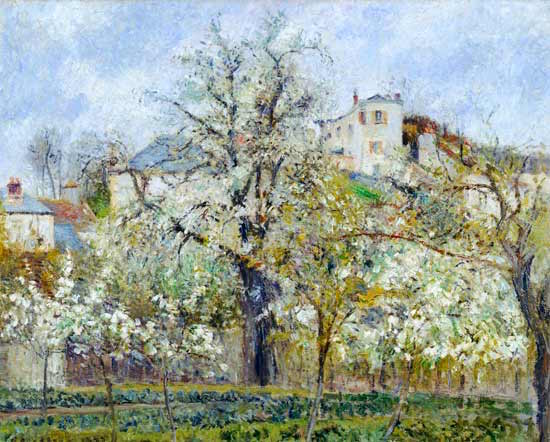 Maybe Sir Lawrence Alma-Tadema’s lavish paeans to springtime are a better fit for the citrus and floral bouquets of champagne. Alma-Tadema’s spectacular carnivals of flowers celebrate the cacophony of colours crashing through the concrete grey of winter. Figures of ethereal beauty lounge dreamily among marble ruins and the dazzling Mediterranean, bursts of blossoms all around. Some literally prance about with flowers on their heads.
Maybe Sir Lawrence Alma-Tadema’s lavish paeans to springtime are a better fit for the citrus and floral bouquets of champagne. Alma-Tadema’s spectacular carnivals of flowers celebrate the cacophony of colours crashing through the concrete grey of winter. Figures of ethereal beauty lounge dreamily among marble ruins and the dazzling Mediterranean, bursts of blossoms all around. Some literally prance about with flowers on their heads.  I love these paintings because they can be enjoyed at face value for their beauty, but their stories have a dark side, too. On the surface, Spring is a sentimental evocation of renewal and harmony. But the artist understood that behind the deceptive celebratory innocence of May Day lurked much darker pagan fertility traditions, and he leaves clues scattered throughout his painting like Easter eggs- inscriptions to the sex god, Priapus, for example. Statues of insatiable satyrs remind viewers in the know that the virginal innocence of the flower maidens leading the procession is an illusion. May Day’s Roman predecessor was Floralia, the festival dedicated to the goddess of spring, Flora, the “flourishing one.” It was, quite literally, an orgy, the feast of prostitutes. It is fashionable today to sneer at the killjoys of the Christian church for their condemnation of such rituals, romanticizing the halcyon days of the goddess’s reign before patriarchy sullied her with fear and loathing. But the idea that pagan times were egalitarian, peaceful days of idyllic liberation is delusional. The festivals were sexytime celebrations to be sure, but they also ritualized the savage Roman theatre of violence. Rape was, in fact, central to the mythology of Flora. She was given reign over the blooming world by the cold wind Favonius as apology for his raping and abducting her. For the Roses of Heliogabalus (pictured at the top of the post), Alma-Tadema reportedly ordered skids of roses to paint a paradise of petals from life. But this work showing beautiful women cavorting on a bed of roses is also not what it seems: the story is another allusion to Roman sadism. Emperor Marcus Aurelius Antoninus fancied himself Heliogabalus, the Syrian sun god. He amused himself by dressing as a woman, drugging his guests’ wine, and smothering them to death in violets and roses. The most famous springtime painting of all is Sandro Botticelli’s Primavera, or Allegory of Springtime. Cherubs and goddesses abound in this lush garden, naked through their diaphanous gowns. We see again the personification of March’s cold wind Favonius, who will turn his victim into spring, queen over all the plants. To represent the magnitude of her role, Botticelli painstakingly rendered some 500 types of botanicals, including almost 200 different flowers.
I love these paintings because they can be enjoyed at face value for their beauty, but their stories have a dark side, too. On the surface, Spring is a sentimental evocation of renewal and harmony. But the artist understood that behind the deceptive celebratory innocence of May Day lurked much darker pagan fertility traditions, and he leaves clues scattered throughout his painting like Easter eggs- inscriptions to the sex god, Priapus, for example. Statues of insatiable satyrs remind viewers in the know that the virginal innocence of the flower maidens leading the procession is an illusion. May Day’s Roman predecessor was Floralia, the festival dedicated to the goddess of spring, Flora, the “flourishing one.” It was, quite literally, an orgy, the feast of prostitutes. It is fashionable today to sneer at the killjoys of the Christian church for their condemnation of such rituals, romanticizing the halcyon days of the goddess’s reign before patriarchy sullied her with fear and loathing. But the idea that pagan times were egalitarian, peaceful days of idyllic liberation is delusional. The festivals were sexytime celebrations to be sure, but they also ritualized the savage Roman theatre of violence. Rape was, in fact, central to the mythology of Flora. She was given reign over the blooming world by the cold wind Favonius as apology for his raping and abducting her. For the Roses of Heliogabalus (pictured at the top of the post), Alma-Tadema reportedly ordered skids of roses to paint a paradise of petals from life. But this work showing beautiful women cavorting on a bed of roses is also not what it seems: the story is another allusion to Roman sadism. Emperor Marcus Aurelius Antoninus fancied himself Heliogabalus, the Syrian sun god. He amused himself by dressing as a woman, drugging his guests’ wine, and smothering them to death in violets and roses. The most famous springtime painting of all is Sandro Botticelli’s Primavera, or Allegory of Springtime. Cherubs and goddesses abound in this lush garden, naked through their diaphanous gowns. We see again the personification of March’s cold wind Favonius, who will turn his victim into spring, queen over all the plants. To represent the magnitude of her role, Botticelli painstakingly rendered some 500 types of botanicals, including almost 200 different flowers. 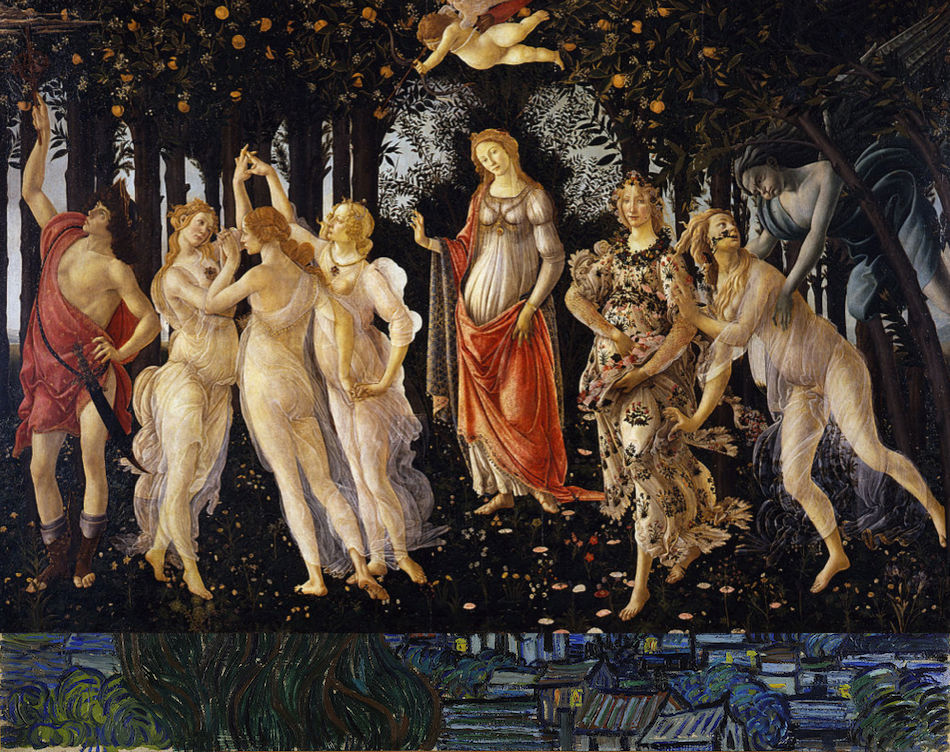 You see, just thinking about spring brings her closer! When every last bubble is emptied from my bottle, I feel lighter and brighter. If I really use my imagination, I can look out at the city sky and see spring in the Starry Night. Yes, spring, I summon you, bring your blooms and stars and things. A precocious little girl approached me on the streetcar this morning, without a trace of shyness. “I love your hat,” she said candidly. The sun was working hard, hoping to make a dent in the tough task of melting the banks of snow. It was below zero, but the 20 degree improvement was intoxicating. I still needed my pirate hat, a cozy affair made out of yak wool or something, with a bright pink motif of skull and crossbones. “Pink is my second favourite colour,” the girl said. “But purple is my most favourite one. I love looking at them. Bright colours make me happy.” She waved her hand in the air like a magic wand just then. “Spring is coming,” she said prophetically. “Soon everything will be pink and purple.”
You see, just thinking about spring brings her closer! When every last bubble is emptied from my bottle, I feel lighter and brighter. If I really use my imagination, I can look out at the city sky and see spring in the Starry Night. Yes, spring, I summon you, bring your blooms and stars and things. A precocious little girl approached me on the streetcar this morning, without a trace of shyness. “I love your hat,” she said candidly. The sun was working hard, hoping to make a dent in the tough task of melting the banks of snow. It was below zero, but the 20 degree improvement was intoxicating. I still needed my pirate hat, a cozy affair made out of yak wool or something, with a bright pink motif of skull and crossbones. “Pink is my second favourite colour,” the girl said. “But purple is my most favourite one. I love looking at them. Bright colours make me happy.” She waved her hand in the air like a magic wand just then. “Spring is coming,” she said prophetically. “Soon everything will be pink and purple.”  Lorette C. Luzajic is an artist and writer with roots in southern Ontario’s wine country soil. Native to Niagara, at home in Toronto, her work is inspired by wine, cheese, and bleak post-apocalyptic literature. Visit her at mixedupmedia.ca. Photo: Ralph Martin.
Lorette C. Luzajic is an artist and writer with roots in southern Ontario’s wine country soil. Native to Niagara, at home in Toronto, her work is inspired by wine, cheese, and bleak post-apocalyptic literature. Visit her at mixedupmedia.ca. Photo: Ralph Martin.
Spring Art and Wine – Champagne Gardens
